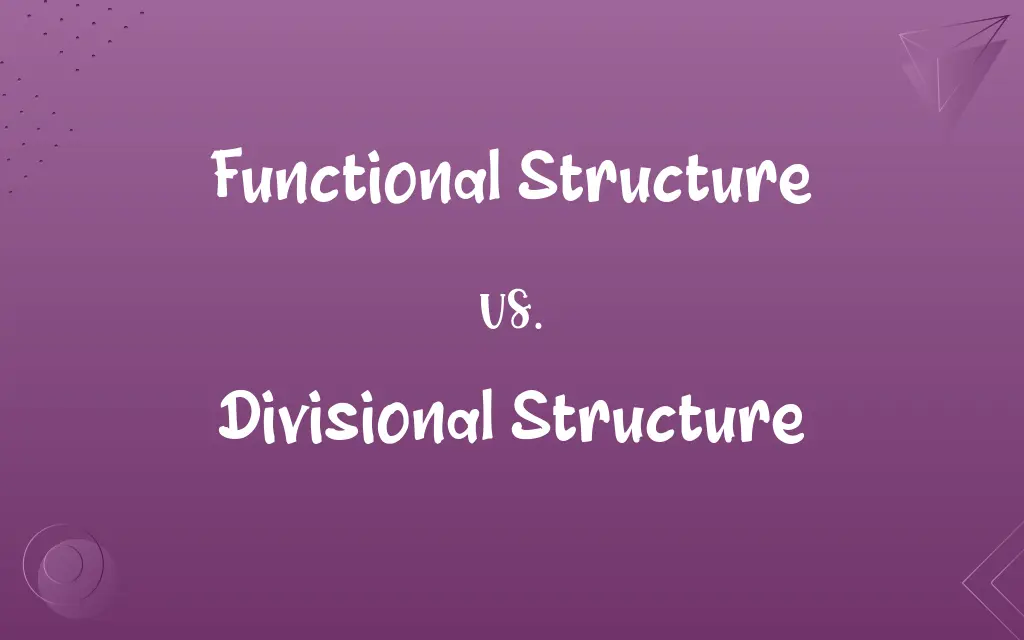Functional Structure vs. Divisional Structure: Know the Difference

By Shumaila Saeed || Published on January 27, 2024
Functional Structure organizes a company into departments or functions (e.g., marketing, finance). Divisional Structure groups divisions based on products, services, or markets.

Key Differences
Functional Structure organizes a business into departments based on specific functions like marketing, finance, and HR. It's efficient for specialized tasks. Divisional Structure groups operations based on products, services, or markets, allowing for focus on specific business areas.
Shumaila Saeed
Jan 27, 2024
In Functional Structure, employees have clear roles within their specialized department, promoting expertise and efficiency in specific tasks. However, in Divisional Structure, each division operates semi-autonomously, with its own resources, which can lead to duplication of efforts across divisions.
Shumaila Saeed
Jan 27, 2024
Functional Structure is ideal for large organizations with diverse activities requiring specialized knowledge in each function. Conversely, Divisional Structure suits organizations with distinct product lines or geographical markets, allowing for tailored strategies.
Shumaila Saeed
Jan 27, 2024
Functional Structure encourages a hierarchical decision-making process, with decisions often made at higher levels. In contrast, Divisional Structure offers greater flexibility and faster decision-making within each division, as they are closer to their specific markets or products.
Shumaila Saeed
Jan 27, 2024
Functional Structure can lead to silos, where departments work independently, sometimes causing lack of communication. Divisional Structure, while offering specialization, can sometimes result in competition among divisions for resources and attention from the central management.
Shumaila Saeed
Jan 27, 2024
ADVERTISEMENT
Comparison Chart
Organizational Basis
Departments or functions (e.g., HR, Finance)
Products, services, or markets
Shumaila Saeed
Jan 27, 2024
Decision Making
Centralized, often at higher levels
Decentralized, within each division
Shumaila Saeed
Jan 27, 2024
Specialization
Focus on specific functions
Focus on specific products or market areas
Shumaila Saeed
Jan 27, 2024
Efficiency
High in specialized tasks
High in market or product-focused strategies
Shumaila Saeed
Jan 27, 2024
Resource Allocation
Shared across the organization
Allocated to each division separately
Shumaila Saeed
Jan 27, 2024
ADVERTISEMENT
Communication
Risk of silos and less cross-departmental interaction
Better within division, but can vary between divisions
Shumaila Saeed
Jan 27, 2024
Suitability
Large, diverse organizations
Organizations with distinct product lines or markets
Shumaila Saeed
Jan 27, 2024
Flexibility
Less, due to departmental boundaries
More, due to division autonomy
Shumaila Saeed
Jan 27, 2024
Interdepartmental Coordination
Less frequent, can be challenging
More within division, less across divisions
Shumaila Saeed
Jan 27, 2024
Adaptability to Change
Slower, due to functional rigidity
Faster, as each division can adapt independently
Shumaila Saeed
Jan 27, 2024
ADVERTISEMENT
Functional Structure and Divisional Structure Definitions
Functional Structure
Promotes expertise in specific fields.
Our IT department thrives due to the functional structure's focus on specialized knowledge.
Shumaila Saeed
Jan 06, 2024
Divisional Structure
Adapts quickly to market changes.
Our fashion division rapidly responds to trends, benefiting from the divisional structure.
Shumaila Saeed
Jan 06, 2024
Functional Structure
Organizes a company into departments based on specific functions.
In a functional structure, the marketing team focuses solely on marketing activities.
Shumaila Saeed
Jan 06, 2024
Divisional Structure
Can lead to duplication of resources.
We have separate marketing teams for each division, which is a downside of divisional structure.
Shumaila Saeed
Jan 06, 2024
Functional Structure
Segregates an organization into specialized groups.
The finance department in a functional structure handles all financial matters.
Shumaila Saeed
Jan 06, 2024
Divisional Structure
Allows autonomy within each division.
Each division in our company, under the divisional structure, makes its own strategic decisions.
Shumaila Saeed
Jan 06, 2024
Functional Structure
Can lead to departmental silos.
The lack of inter-departmental communication is a drawback of our functional structure.
Shumaila Saeed
Jan 06, 2024
Divisional Structure
Facilitates focus on specific business areas.
Our automotive division focuses solely on car manufacturing, a clear advantage of the divisional structure.
Shumaila Saeed
Jan 06, 2024
Functional Structure
Enhances operational efficiency within specialized areas.
In our functional structure, the HR team efficiently manages all employee-related processes.
Shumaila Saeed
Jan 06, 2024
Divisional Structure
Groups an organization based on products, services, or markets.
Our company's electronics division operates independently, a characteristic of divisional structure.
Shumaila Saeed
Jan 06, 2024
Repeatedly Asked Queries
What defines a functional structure?
Organization based on departments or functions.
Shumaila Saeed
Jan 27, 2024
How does communication typically flow in a Functional Structure?
Vertically, up and down the hierarchy within each functional department.
Shumaila Saeed
Jan 27, 2024
What is a divisional structure?
Grouping based on products, services, or markets.
Shumaila Saeed
Jan 27, 2024
What are the disadvantages of a Functional Structure?
Limited cross-functional collaboration, potential for silos, and slower decision-making.
Shumaila Saeed
Jan 27, 2024
How does a Functional Structure promote expertise development?
Employees within each function can specialize and develop deep expertise in their areas.
Shumaila Saeed
Jan 27, 2024
What types of businesses are best suited for a Functional Structure?
Large organizations with a clear division of labor and well-defined functions.
Shumaila Saeed
Jan 27, 2024
Give an example of a company using a Functional Structure.
A manufacturing company with separate departments for production, marketing, finance, and HR.
Shumaila Saeed
Jan 27, 2024
Can a Functional Structure adapt easily to changes in the external environment?
It may be less flexible compared to other structures, but adaptability depends on the organization's culture and leadership.
Shumaila Saeed
Jan 27, 2024
Give an example of a company using a Divisional Structure.
A multinational corporation with separate divisions for each geographic region it operates in.
Shumaila Saeed
Jan 27, 2024
What is the role of top management in a Divisional Structure?
Top management oversees overall strategy, sets divisional goals, and ensures coordination between divisions.
Shumaila Saeed
Jan 27, 2024
What is the role of top management in a Functional Structure?
They oversee the entire structure and coordinate activities among different functional departments.
Shumaila Saeed
Jan 27, 2024
Can a Divisional Structure be efficient for resource allocation?
It can be efficient if divisional leaders have control over their resources and budgets.
Shumaila Saeed
Jan 27, 2024
What are the disadvantages of a Divisional Structure?
Potential for duplication of resources, limited economies of scale, and challenges in coordinating between divisions.
Shumaila Saeed
Jan 27, 2024
What types of businesses are best suited for a Divisional Structure?
Companies with diverse product lines, multiple geographic markets, or varying customer needs.
Shumaila Saeed
Jan 27, 2024
How does communication flow in a Divisional Structure?
Both vertically and horizontally, with communication between divisions and from top management to divisional leaders.
Shumaila Saeed
Jan 27, 2024
What are the advantages of a Divisional Structure?
Faster decision-making, adaptability to diverse markets, and accountability at the divisional level.
Shumaila Saeed
Jan 27, 2024
How does a Divisional Structure support market responsiveness?
Each division can tailor its strategies to specific markets, allowing for quicker responses to market changes.
Shumaila Saeed
Jan 27, 2024
Share this page
Link for your blog / website
HTML
Link to share via messenger
About Author
Written by
Shumaila SaeedShumaila Saeed, an expert content creator with 6 years of experience, specializes in distilling complex topics into easily digestible comparisons, shining a light on the nuances that both inform and educate readers with clarity and accuracy.









































































